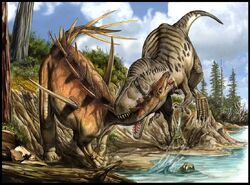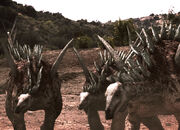m (→References: Removing Category:Dinosaurs in Popular Culture) Tag: apiedit |
m (→References: removing Category:Ornithischians) Tag: apiedit |
||
| Line 39: | Line 39: | ||
[[Category:Reptiles]] |
[[Category:Reptiles]] |
||
[[Category:Herbivores]] |
[[Category:Herbivores]] |
||
| − | [[Category:Ornithischians]] |
||
[[Category:Archosaurs]] |
[[Category:Archosaurs]] |
||
[[Category:Prehistoric Life]] |
[[Category:Prehistoric Life]] |
||
Revision as of 15:24, 10 May 2015
Miragaia (meer-UH-guy-UH) was a stegosaur that lived in Late Jurassic Portugal about 150 million years ago. It was discovered in 2009 by a paleontologist named Octávio Mateus. Miragaia also has one of the shortest names for dinosaurs.
Description
Miragaia was herbivorous, like all stegosaurs. It's closely related to the more famous Stegosaurus and Kentrosaurus. It had several plates that went down along its back, possibly for thermal regul

Miragaia Skeleton
ating or attracting mates and scaring off rivals or predators. It had long spikes that came out of each shoulder, possibly for display. It also had several spikes on its tail (thagomizer) that it could use to hit predators with and scare off, if not injure or kill it. It was a quadruped, and walked around on four stout, slow-moving legs, but Miragaia was so well defended it didn't need to run fast. One feature that sets Mirigaia apart form other stegosaurs is its extended neck with 17 vertebrae in it. It travelled in herds containing juveniles, adults, and seniors. It grew to be about 20 ft (6 m) long from nose to tail, with the extended neck making up a lot of it. It lived alongside the sauropod

Deinhierosaurus, pterosaurs like Rhamphorhynchus, and predators like Ornitholestes, Torvosaurus, and Allosaurus. This represents the culmination of a trend of longer necks seen in stegosaurians. Additionally, Miragaia had more neck vertebrae than most sauropods, dinosaurs known for their long necks, which contrasts with the traditional view of stegosaurians as low browsers with short necks. Only the Chinese sauropods Euhelopus, Mamenchisaurus, and Omeisaurus had as many neck vertebrae as Miragaia, with most sauropods of the Late Jurassic possessing only 12 to 15. Mateus and colleagues suggested that the long neck either allowed Miragaia to browse at a level that other herbivores were not exploiting, or that the neck arose due to sexual selection.

In Popluar Culture

Torvosaurus vs Miragaia
Mirigaia was in the documentary Dinosaur Revolution, where a herd of them lived by a dried up watering hole and l

Dinosaur Revolution Miragaia
ived near a Deinhierosaurus herd and an Allosaurus. It then helped to take down a Torvosaurus when it nearly stepped on one of their babies.
References
Websites:
http://en.wikipedia.org/wiki/Miragaia_(dinosaur)
http://www.prehistoric-wildlife.com/species/m/miragaia.html
http://dsc.discovery.com/tv/dinosaur-revolution/photos/watering-hole-pictures-06.html
Documentaries:
Dinosaur Revolution
